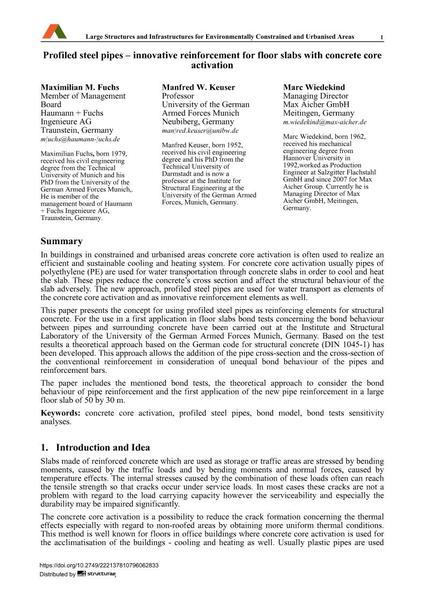Profiled steel pipes – innovative reinforcement for floor slabs with concrete core activation

|
|
|||||||||||
Détails bibliographiques
| Auteur(s): |
Maximilian M. Fuchs
Manfred W. Keuser Marc Wiedekind |
||||
|---|---|---|---|---|---|
| Médium: | papier de conférence | ||||
| Langue(s): | anglais | ||||
| Conférence: | IABSE Symposium: Large Structures and Infrastructures for Environmentally Constrained and Urbanised Areas, Venice, Italy, 22-24 September 2010 | ||||
| Publié dans: | IABSE Symposium Venice 2010 | ||||
|
|||||
| Page(s): | 570-571 | ||||
| Nombre total de pages (du PDF): | 8 | ||||
| Année: | 2010 | ||||
| DOI: | 10.2749/222137810796062833 | ||||
| Abstrait: |
In buildings in constrained and urbanised areas concrete core activation is often used to realize an efficient and sustainable cooling and heating system. For concrete core activation usually pipes of polyethylene (PE) are used for water transportation through concrete slabs in order to cool and heat the slab. These pipes reduce the concrete’s cross section and affect the structural behaviour of the slab adversely. The new approach, profiled steel pipes are used for water transport as elements of the concrete core activation and as innovative reinforcement elements as well. This paper presents the concept for using profiled steel pipes as reinforcing elements for structural concrete. For the use in a first application in floor slabs bond tests concerning the bond behaviour between pipes and surrounding concrete have been carried out at the Institute and Structural Laboratory of the University of the German Armed Forces Munich, Germany. Based on the test results a theoretical approach based on the German code for structural concrete (DIN 1045-1) has been developed. This approach allows the addition of the pipe cross-section and the cross-section of the conventional reinforcement in consideration of unequal bond behaviour of the pipes and reinforcement bars. The paper includes the mentioned bond tests, the theoretical approach to consider the bond behaviour of pipe reinforcement and the first application of the new pipe reinforcement in a large floor slab of 50 by 30 m. |
||||
